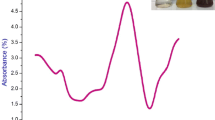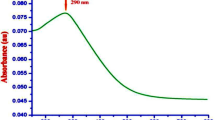Abstract
Anopheles stephensi is a mosquito of outstanding public health relevance, acting as a major vector of malaria in a number of tropical and subtropical areas worldwide. In recent years, important efforts have been conducted to propose nano-formulated larvicides as valuable alternatives to synthetic insecticides currently marketed. In the present study, the toxicity of flower-like copper sulfide (CuS) nanocrystals has been investigated on the malaria vector A. stephensi and Plasmodium parasites. Characterization of synthesized CuS nanocrystals was carried out using FTIR spectroscopy, XRD analysis, FESEM, HR-TEM and EDS. In mosquitocidal assays, LC50 values ranged from 23.347 ppm (first-instar larvae) to 48.789 ppm (pupae). In vitro anti-plasmodial activity of CuS nanoflowers was evaluated against chloroquine-resistant (CQ-r) and CQ-sensitive (CQ-s) strains of Plasmodium falciparum. IC50 were 83.44 μg/mL (CQ-s) and 87.15 μg/mL (CQ-r). However, in vivo antiplasmodial experiments conducted on Plasmodium berghei infecting albino mice showed limited activity of CuS nanocrystals, if compared to CQ. Overall, our findings showed that chemically synthesized flower-like CuS nanocrystals are promising to improve the effectiveness of mosquito control programs, as well as to develop novel antiplasmodial drugs.







Similar content being viewed by others
References
G. Benelli and H. Mehlhorn (2016). Parasitol. Res. doi:10.1007/s00436-016-4971-z.
G. Benelli, A. Lo Iacono, A. Canale, and H. Mehlhorn (2016). Parasitol. Res. doi:10.1007/s00436-016-5037-y.
E. J. Muturi, P. Burgess, and R. J. Novak (2008). Am. J. Trop. Med. Hyg. 78, 536.
H. Mehlhorn Encyclopedia of Parasitology, vol. 3rd edn (Springer, New York, 2008).
WHO (2016). Zika virus. Fact sheet N1. Updated Jan 2016
J. G. Breman, A. S. Martin, and A. Mills (2004). Am. J. Trop. Med. Hyg. 71, 1.
R. W. Snow, C. A. Guerra, A. M. Noor, H. Y. Myint, and S. I. Hay (2005). Nature 434, 214.
V. P. Sharma (2003). Curr. Sci. 84, 513.
C. Kuppusamy and K. Murugan (2009). Int. J. Integr. Biol. 5, 75.
A. T. Aziz, J. A. Mahyoub, H. Rehman, S. Saggu, K. Murugan, C. Panneerselvam, M. Nicoletti, H. Wei, A. Canale, and G. Benelli (2016). Asian. Pac. J. Trop. Biomed. doi:10.1016/j.apjtb.2015.12.017.
J. Hemingway and H. Ranson (2000). Annu. Rev. Entomol. 45, 371.
M. N. Naqqash, A. Gokce, A. Bakhsh, and M. Salim (2016). Parasitol. Res. 115, 1363.
K. Murugan, C. Panneerselvam, C. M. Samidoss, P. Madhiyazhagan, U. Suresh, M. Roni, B. Chandramohan, J. Subramaniam, D. Dinesh, R. Rajaganesh, M. Paulpandi, H. Wei, A. T. Aziz, M. Saleh Alsalhi, S. Devanesan, M. Nicoletti, R. Pavela, A. Canale, and G. Benelli (2016). Res. Vet. Sci. 106, 14.
K. Murugan, D. Dinesh, K. Kavithaa, M. Paulpandi, T. Ponraj, M. Saleh Alsalhi, S. Devanesan, J. Subramaniam, R. Rajaganesh, H. Wei, K. Suresh, M. Nicoletti, and G. Benelli (2016). Parasitol. Res. 115, 1085.
S. Devasenan, N. Hajara Beevi, and S. S. Jayanthi (2016). Int. J. ChemTech. Res. 9, 725.
G. Benelli (2016). Parasitol. Res. 115, 23.
G. Benelli (2016). Asian. Pac. J. Trop Biomed. doi:10.1016/j.apjtb.2015.10.015.
R. Narayanan and M. A. El-Sayed (2003). J. Am. Chem. Soc. 125, 8340.
G. Borkow (2010). Wound. Repair. Regen. 18, 266.
G. Borkow, R. C. Zatcoff, and J. Gabbay (2009). Med. Hypotheses. 73, 883.
L. C. Carnes and K. J. Klabunde (2003). J. Mol. Catal. A. Chem 194, 227.
Z. Guo, X. Liang, T. Pereira, R. Scaffaro, and H. T. Hahn (2007). Sci. Tech. 67, 2036.
Y. Li, J. Liang, Z. Tao, and J. Chen (2008). Mater. Res. Bull. 43, 2380.
C. Hyungsoo and P. Sung-Ho (2004). J. Am. Chem. Soc. 126, 6248.
L. Huang, H. Jiang, J. Zhang, Z. Zhang, and P. Zhang (2006). Electrochem. Commun. 8, 262.
N. Aruldhas, C. P. Raj, and A. Gedanken (1998). Chem. Mater. 10, 1446.
H. Hashemipour, M. E. Z. Rahimi, R. Pourakbari, and P. Rahimi (2011). J. Phys. Sci. 6, 4331.
N. V. Surmawar, S. R. Thakare, and N. T. Khaty (2011). Int. J. Green. Nanotechnol. 3, 302.
P. K. Khanna, S. Gaikwad, P. V. Adhyapak, N. Singh, and R. Marimuthu (2007). Mater. Lett. 61, 4711.
D. Dinesh, K. Murugan, P. Madhiyazhagan, C. Panneerselvam, M. Nicoletti, W. Jiang, G. Benelli, B. Chandramohan, and U. Suresh (2015). Parasitol. Res. 114, 1519.
W. Trager and J. Jensen (1976). Science 193, 673.
M. Smilkstein, N. Sriwilaijaroen, J. X. Kelly, P. Wilairat, and M. Riscoe (2004). Antimicrob. Agents Chemother. 48, 1803.
A. Bagavan, A. A. Rahuman, N. K. Kaushik, and D. Sahal (2011). Parasitol. Res. 108, 15.
A. Ishih, T. Suzuki, M. Watanabe, T. Miyase, and M. Terada (2003). Phytother. Res. 17, 1234.
W. Peters, J. H. Portus, and B. L. Robinson (1975). Ann. Tropic. Med. Parasitol 69, 155.
M. C. Gessler, D. E. Msuya, and M. H. H. Nkunya (1995). J. Ethnopharmacol. 48, 131.
D. J. Finney Probit Analysis, 3rd ed (Canbridge University Press, Cambridge, 1971).
J. Theerthagiri, R. A. Senthil, A. Malathi, A. Selvi, J. Madhavan, and M. Ashokkumar (2015). RSC. Adv. 5, 52718.
J. Theerthagiri, B. Shankar, M. Dalavi, R. Manivel, and R. N. Panda (2013). Mater. Res. Bull. 48, 4444.
M. Rajesh (2016). Int. Adv. Res. J. Sci. Eng Technol. 3, 37.
O. Mahapatraa, M. Bhagatb, C. Gopalakrishnana, and K. D. Arunachalamb (2008). J Exp Nanosci 3, (3), 185–193.
D. V. Judith, D. Carla, P. Claudio, B. Abraham, P. Carlos, and G. Apolinaria (2012). Int. J. Nanomed. 7, 3597–3612.
R. Ridzuan, R. K. Maksudur, K. C. Najmul, D. H. B. Mohammad, M. H. Rohaya, A. A. Astimar, I. Zawawi, and H. Z. Nahrul (2013). Adv. Nanopart. 2, 358.
U. Suresh, K. Murugan, G. Benelli, M. Nicoletti, D. R. Barnard, C. Panneerselvam, P. Mahesh Kumar, J. Subramaniam, D. Dinesh, and B. Chandramohan (2015). Parasitol. Res. doi:10.1007/s00436015-4339-9.
G. Benelli (2016). Enzyme. Microb. Technol. doi:10.1016/j.enzmictec.2016.08.022.
J. Ramyadevi, K. Jeyasubramanian, A. Marikani, G. Rajakumar, A. A. Rahuman, S. Santhoshkumar, A. Vishnu Kirthi, C. Jayaseelan, and S. Marimuthu (2011). Parasitol. Res. 109, 1403.
A. V. Kirthi, A. A. Rahuman, G. Rajakumar, S. Marimuthu, T. Santhoshkumar, C. Jayaseelan, and K. Velayutham (2011). Parasitol. Res. doi:10.1007/s00436-011-2277-8.
K. Murugan, C. M. Samidoss, C. Panneerselvam, A. Higuchi, M. Roni, U. Suresh, B. Chandramohan, J. Subramaniam, P. Madhiyazhagan, D. Dinesh, R. Rajaganesh, A. A. Alarfaj, M. Nicoletti, S. Kumar, H. Wei, A. Canale, H. Mehlhorn, and G. Benelli (2015). Parasitol. Res. 114, 4087.
K. Murugan, C. Panneerselvam, J. Subramaniam, P. Madhiyazhagan, J. S. Hwang, L. Wang, D. Dinesh, U. Suresh, M. Roni, A. Higuchi, M. Nicoletti, and G. Benelli (2016). Environ. Sci. Pollut. Res. doi:10.1007/s11356-016-6832-9.
S. Ravikumar, G. Ramanathan, S. J. Inbaneson, and A. Ramu (2011). Parasitol. Res. 108, 107.
L. P. Ouattara, S. Sanon, V. Mahiou-Leddet, A. Gansané, B. Baghdikian, A. Traoré, I. Nébié, A. S. Traoré, N. Azas, E. Ollivier, and S. B. Sirima (2014). Parasitol. Res. 113, 405.
A. Jaganathan, K. Murugan, C. Panneerselvam, P. Madhiyazhagan, D. Dinesh, C. Vadivalagan, A. T. Aziz, B. Chandramohan, U. Suresh, R. Rajaganesh, J. Subramaniam, M. Nicoletti, A. Higuchi, A. A. Alarfaj, M. A. Munusamy, S. Kumar, and G. Benelli (2016). Parasitol. Int. 65, 276–284.
Author information
Authors and Affiliations
Corresponding author
Ethics declarations
Conflicts of interest
The Authors declare no conflicts of interest.
Ethical approval
All applicable international and national guidelines for the care and use of animals were followed. All procedures performed in studies involving animals were in accordance with the ethical standards of the institution or practice at which the studies were conducted.
Informed consent
Informed consent was obtained from all individual participants included in the study.
Rights and permissions
About this article
Cite this article
Theerthagiri, J., Madhavan, J., Murugan, K. et al. Flower-Like Copper Sulfide Nanocrystals are Highly Effective Against Chloroquine-Resistant Plasmodium falciparum and the Malaria Vector Anopheles stephensi . J Clust Sci 28, 581–594 (2017). https://doi.org/10.1007/s10876-016-1128-2
Received:
Published:
Issue Date:
DOI: https://doi.org/10.1007/s10876-016-1128-2




